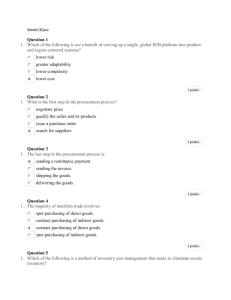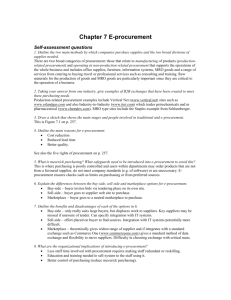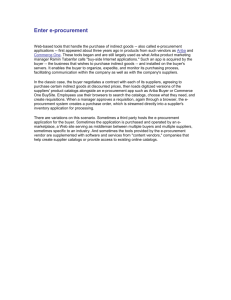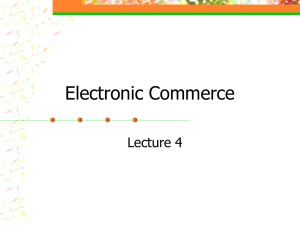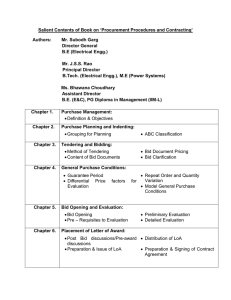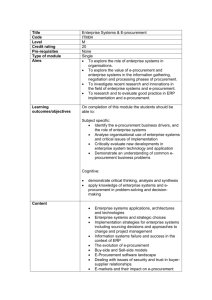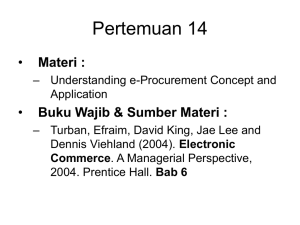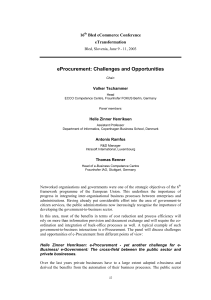Document 13732016
advertisement
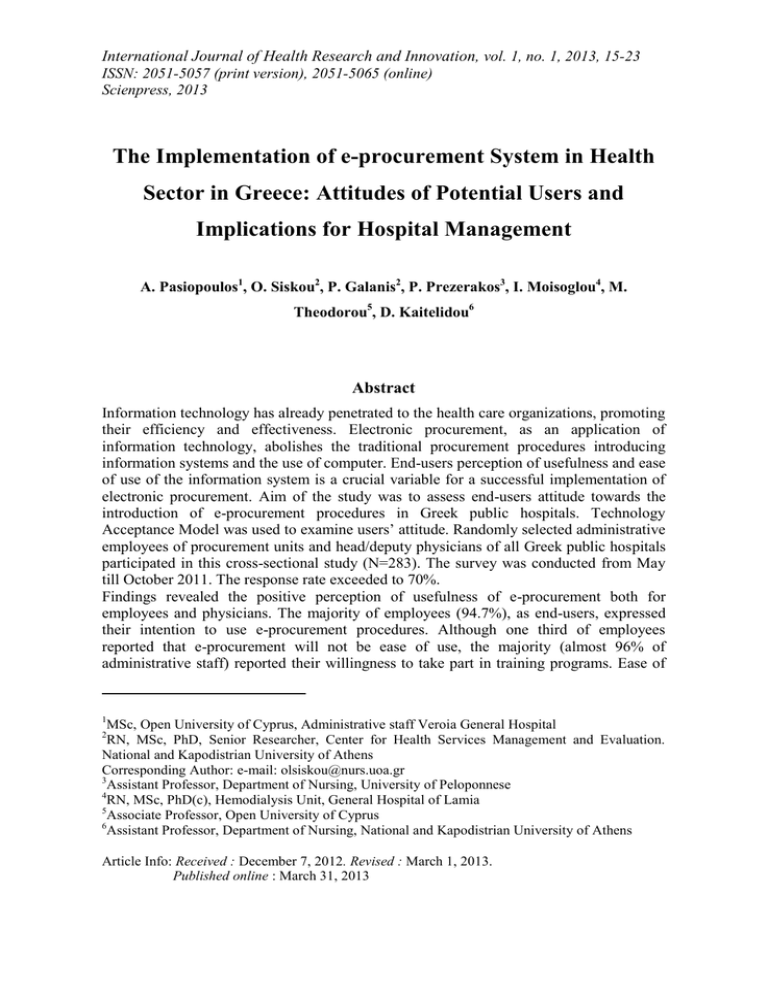
International Journal of Health Research and Innovation, vol. 1, no. 1, 2013, 15-23 ISSN: 2051-5057 (print version), 2051-5065 (online) Scienpress, 2013 The Implementation of e-procurement System in Health Sector in Greece: Attitudes of Potential Users and Implications for Hospital Management A. Pasiopoulos1, O. Siskou2, P. Galanis2, P. Prezerakos3, I. Moisoglou4, M. Theodorou5, D. Kaitelidou6 Abstract Information technology has already penetrated to the health care organizations, promoting their efficiency and effectiveness. Electronic procurement, as an application of information technology, abolishes the traditional procurement procedures introducing information systems and the use of computer. End-users perception of usefulness and ease of use of the information system is a crucial variable for a successful implementation of electronic procurement. Aim of the study was to assess end-users attitude towards the introduction of e-procurement procedures in Greek public hospitals. Technology Acceptance Model was used to examine users’ attitude. Randomly selected administrative employees of procurement units and head/deputy physicians of all Greek public hospitals participated in this cross-sectional study (N=283). The survey was conducted from May till October 2011. The response rate exceeded to 70%. Findings revealed the positive perception of usefulness of e-procurement both for employees and physicians. The majority of employees (94.7%), as end-users, expressed their intention to use e-procurement procedures. Although one third of employees reported that e-procurement will not be ease of use, the majority (almost 96% of administrative staff) reported their willingness to take part in training programs. Ease of 1 MSc, Open University of Cyprus, Administrative staff Veroia General Hospital RN, MSc, PhD, Senior Researcher, Center for Health Services Management and Evaluation. National and Kapodistrian University of Athens Corresponding Author: e-mail: olsiskou@nurs.uoa.gr 3 Assistant Professor, Department of Nursing, University of Peloponnese 4 RN, MSc, PhD(c), Hemodialysis Unit, General Hospital of Lamia 5 Associate Professor, Open University of Cyprus 6 Assistant Professor, Department of Nursing, National and Kapodistrian University of Athens 2 Article Info: Received : December 7, 2012. Revised : March 1, 2013. Published online : March 31, 2013 16 A. Pasiopoulos et al. use internet, was significantly correlated with the perception of ease to use e-procurement (p=0.001). At last, in a percentage that approximately amounts 80%, employees consider that the cost of the materials’ provision is going to be reduced, by the application of the electronic procurement system. Due to the economic crisis and the necessity for cost containment Ministry of Health, identifying the benefits of e-procurement, has to take advantage of the positive attitude of end-users and put on, as a priority the development and implementation of e-procurement systems in hospital sector. 1 Introduction Governments face up to an increasing cost of health sector, while at the same time they have to reduce their budgets. Hospital administrators have to provide safe and high quality health care services under the pressure of limited resources. Innovative and expensive medicines constantly evolved biomedical technology and aging population are some of the major factors that rise health care costs [1]. Computers, information systems and technologies have penetrated to health care organizations and enhanced their performance by providing better communication, access to information and knowledge and promoting innovation and efficiency [2]. Electronic procurement (e-procurement), as an information technology application, consists of a useful tool for administrators to save money and increase organizations’ effectiveness and efficiency. Process cost savings, reduced administration costs, decrease in costs through reduced staffing levels, increased quality through increased competition, reduction in time through improved internal workflow and shortened overall procurement cycle times compose some of the benefits that stem of e-procurement process [3, 4]. A well designed process and policy willing can be essential pre-conditions for eprocurement implementation. However, there is a crucial variable which put at risk the success of the implementation. This variable tends to be users’ acceptance of the new process. E-procurement consists change for the organization and specifically for the employees of the procurement unit. Abolition of the traditional handwritten procedure and its replacement of new procedures based on the use of computer and information technology consist some of the major changes. Resistance to change is a barrier for eprocurement process construction and users’ acceptance isn’t considered given. Davis [5, 6, 7] developed and validated the Technology Acceptance Model (TAM) to explain the mechanisms that influence and shape users’ acceptance of new information technology. According to TAM, there are two specific variables that are fundamental determinants of users’ attitude toward using information technology and actual use of the system: perceived usefulness and perceived ease of use relatively to new information system design features. Usefulness is defined as the degree to which someone believes that using a system will enhance his performance and ease of use is defined as the degree to which user believes that benefits of systems’ use are outweighed the efforts for using it. Before e-procurement implementation, administrators have to assess employees’ attitude across to this new information technology, in order to prevent a failure in implementation and waste of resources. The Implementation of e-procurement System in Health Sector in Greece 17 2 Aim The aim of the study was to assess the attitude of administrative employees of procurement units, head physicians and deputy head physicians of public hospitals to the introduction of e-procurement procedures in their hospitals. Head physicians and deputy head physicians were included to the study, because they get involved in the process by drawing up the technical characteristics of the medical supplies. 3 Sample Randomly selected administrative employees of the procurement units, head physicians and deputy head physicians of all (135) Public Greek Hospitals participated in this crosssectional study. Permission was granted by Administration Board of the 7 Regional Health Authorities. All questionnaires were sent via Fax. Each one was accompanied by a letter describing the personal data of researchers, the aim of study and ethical aspects (anonymity and voluntary participation). Participants returned the completed questionnaires via Fax. The period during which the study was conducted was May 1st to October 31th 2011. One hundred eighty nine completed questionnaires were returned and analyzed, out of the 268 that were sent (response rate 70.52%). Instrument Researchers used two questionnaires, one for administrative employees and one for the physicians. The questionnaires were developed by the researchers based on literature and experts recommendations. A pilot study was conducted. Thirty five administrative employees were interviewed by the researchers Administrative employees’ questionnaire consisted of four parts. First one (16 questions) referred to the perceived usefulness of e-procurement implementation to the hospital and the second (4 questions) to the perceived ease of use it. At the third part (4 questions) participants completed their demographic characteristics. Finally at the fourth (2 questions) they answered about their work status. Head and deputy physicians’ questionnaire consisted of two parts. The first part (12 questions) referred to the perceived usefulness of e-procurement implementation to the hospital where the second (5 questions) to demographics and work status. Data analysis Categorical variables are presented as absolute and relative frequencies, while continuous data are presented as mean (standard deviation). The normality assumption was evaluated both using the Kolmogorov-Smirnov criterion (p>0.05 for all variables) and normal probability plots. Continuous variables appeared reasonably normally distributed. Relations between categorical variables were estimated by chi-square test, Fisher’s exact test and chi-square trend test. A t-test was used in order to explore the relation between a continuous and a dichotomous variable. A two sided p-value <0.05 was considered statistically significant. The Statistical Package for Social Sciences (IBM SPSS) program, version 19.0 (Chicago, Illinois, USA) was used for statistical analysis. 18 A. Pasiopoulos et al. 4 Results Demographic characteristics of the participants are shown in Table 1. Administrative employees (97.4%) together with the physicians (90.4%) reported that the current procurement procedure has to change. The use of information technology is essential for the improvement of the procurement procedure answered the majority of the employees and physicians. The introduction of e-procurement into public hospitals is indispensable according to 93.7% of the employees and 89.4% of the physicians. The introduction and use of e-procurement will make the procedures more transparent, safe, quick and will reduce transaction costs. E-procurement will increase the competition and contribute to increased patients’ satisfaction of the public hospitals. Descriptive results about perceived usefulness of e-procurement are summarized in Table 2. Thirty nine percent of the employees answered that the e-procurement process won’t be easy and simply to use, while another 34.4% believed the opposite. The majority of employees (95.8%) were willing to learn how to use the new process and take part in training programs, either during their work time either after that. Employees reported that e-procurement will facilitate their work and consequently they will take better control over their work. Descriptive results about perceived ease of use e-procurement are shown in Table 3. The majority (94.7%) of employees expressed their intention to use the e-procurement process. Ninety three per cent of the employees reported that they have great/moderate ease of use internet. The ease of internet use was significantly correlated with the perception that e-procurement have to introduced into public hospitals (p=0.001) and even immediately (0.007) and that information technology is essential for the improvement of procurement procedures (p=0.02). Also, the ease of internet use was associated with the perception that e-procurement process will be easy and simply to use (p=0.03) and with the willingness to participate in training programs (p=0.01). Another significant finding was that ease of internet use, was correlated with the intention to use the e-procurement procedure (p=0.02). Ease of internet use and its statistical significant correlations are shown in Table 4. About 60% of physicians expressed the opinion that the e-procurement system has immediately to be implemented, while only 33% of administrative staff expressed the same opinion, a difference that is statistical significant (p<0,0004). 5 Discussion Findings of the present study revealed the respondents’ positive perception of usefulness of e-procurement for the organizations. The findings are consistent with findings of other studies in Malaysia [8] and Australia [9]. Davis [5] confirmed in his study, followed the TAM introduction, the strong and significant direct and indirect (through attitude) effect that perceived usefulness have on actual use. Chau and Hu [10] research among physicians on telemedicine technology acceptance found usefulness perception as the most significant factor for the acceptance of the telemedicine technology. Greek public health sector is undergoing the devastating effects of economic crisis. Ministry of health decreased its budget by 1.4 billion euro for the year of 2011. Two thirds of this reduction targeted the hospitals’ operating costs [11]. Recently, the Greek Minister of Health presented the results of an e-auction for medicines supply, announcing a 99.6% reduction The Implementation of e-procurement System in Health Sector in Greece 19 on medicines prices. Perceived usefulness, combined with the high percentage (94.7%) of intention to use e-procurement, creates the conditions for a successful implementation of it in health sector and gives to the Greek Government the opportunity to get the direct and indirect benefits that stem of e-procurement process. Although, the majority of employees believe that e-procurement will facilitate their work, only 1 to 3 answered that e-procurement will be easy and simply to use. Also the majority expressed their willingness to participate in training programs for e-procurement. Studies have demonstrated that employees’ training is a crucial factor for perception of ease of use and acceptance of information technology [9, 12]. The lack of system knowledge may create anxiety, negative attitude and diffusion to use e-procurement technology. Training programs provide knowledge and primarily experience of computers and new information technology, making employees more confident [13]. According to our findings, perception about e-procurements’ ease of use, was significantly associated with those that reported ease of internet use. This finding is consistent with findings of other studies [14, 15], where individuals’ computer self-efficacy and system experience had a significantly positive effect on perceived ease of use of the specific system. 5 Conclusion The economic crisis that undergoing the Greek Government has deprived of health sector important resources. E-procurement and information technology can help administrators to save money through more effective and efficiency procedures. Our study findings revealed end-users perception of usefulness, willingness to learn new information systems and their intention to use them, making way for a successful e-procurement implementation. Greek Government and public health sector agencies, identifying the benefits of e-procurement, have to take advantage of the positive attitude of end-users and put on as a priority the development and implementation of e-procurement. References [1] [2] [3] [4] N. Maniadakis, V. Fragoulakis and P. Prezerakos, “Comparative costs of new technology in health,” Society, Economy and Health, vol. 1, July - December 2007, pp. 92-106. (in Greek) T. Dewett and G. R. Jones, “The role of information technology in the organization: a review, model, and assessment,” Journal of Management, vol. 27, no. 3, June 2001, pp. 313-346. R. Eadie, S. Perera and G. Heaney, “Identification of e-procurement drivers and barriers for UK construction organizations and ranking of these from the perspective of quantity surveyors,” Journal of Information Technology in Construction, vol. 15, 2010, pp.23-43. A. Davila, M. Gupta and R. Palmer, “Moving procurement systems to the internet: the adoption and use of e-procurement technology models,” European Management Journal, vol. 21, no. 1, February 2003, pp. 11-23. 20 A. Pasiopoulos et al. [5] F. D. Davis, “A technology acceptance model for empirically testing new end – user information systems: theory and results,” Ph. D. dissertation, MIT Sloan School of Management, Cambridge, MA, 1986. F. D. Davis, “Perceived usefulness, perceived ease of use, and user acceptance of information technology,” MIS Quarterly, vol. 13, no. 3, September 1989, pp. 319340. F. Davis, “User acceptance of information technology: system characteristics, user perceptions and behavioral impacts,” International Journal of Man-Machine Studies, vol. 38, no. 3, March 1993, pp. 475-487. M. Kaliannan, H. Awang, M. Raman and M. Dorasamy, “e-Procurement for the public sector: Determinants of attitude towards adoption,” http://ww.csisigegov.org/critical_pdf/25_224-234.pdf. M. Rahim, “Identifying factors affecting acceptance of e-procurement systems: An initial qualitative study at an Australian City Council,” vol. 3, no. 2, 2008, pp. 7-17. P.Y.K Chau and P. Jen-Hwa Hu, “Information technology acceptance by individual professionals: A model comparison approach,” Decision Sciences, vol. 32, no. 4, Fall 2001, pp. 699-719. D. Kaitelidou and E. Kouli, “Greece: The health system in a time of crisis,” Eurohealth, vol. 18, no. 1, 2012, pp. 12-14. R. Nelson and P. Cheney, “Training end users: An exploratory study,” MIS Quarterly, vol. 11, no. 4, December 1987, pp. 547-559. T. Levine and S. Donitsa-Schmidt, “Computer use, confidence, attitudes, and knowledge: A causal analysis,” Computers in Human Behavior, vol. 14, no. 1, January 1998, pp. 125-146. G. Hackbarth, V. Grover and M. Y. Yi, “Computer playfulness and anxiety: positive and negative mediators of the system experience effect on perceived ease of use,” Information & Management, vol. 40, no. 3, January 2003, pp. 221-232. V. Venkatesh and F.D Davis, “A model of the antecedents of perceived ease of use: Development and test,” Decision Sciences, vol. 27, no. 3, Summer 1996, pp. 451481. [6] [7] [8] [9] [10] [11] [12] [13] [14] [15] The Implementation of e-procurement System in Health Sector in Greece 21 Appendix Characteristic Table 1: Demographic characteristics of the participants Employees Physicians Gender Female Male Agea Education level Higher school University diploma Master/PhD Degree Work position Head physician Deputy head physician Manager Deputy manager Employee Years of experiencea a 134 (70.9) 55 (29.1) 42.2 (7.1) 29 (30.9) 65 (69.1) 54.8 (6.5) 70 (37) 96 (50.8) 23 (12.2) 66 (70.23) 28 (29.8) 20 (10.6) 33 (17.4) 136 (72) 14.6 (8.5) 22.76 (0.1) Mean (standard deviation) Values are expressed as n (%). Table 2: Perceived usefulness of e-procurement according to the respondents Employees Information technology will improve procurement procedure E-procurements’ introduction into Public hospitals is essential E-procurement will make procedures more transparent E-procurement will make procedures more safe E-procurement will make procedures more quick E-procurement will reduce transaction costs E-procurement will increase the competition E-procurement will increase patients’ satisfaction 187 (98.9) Physicians 90 (95.7) 177 (93.7) 84 (89.4) 135 (71.4) 76 (80.9) 112 (59.3) 60 (63.8) 149 (78.8) 83 (88.3) 142 (75.1) 75 (79.8) 123 (65.1) 66 (70.2) 108 (57.2%) Values are expressed as n (%). * this question was not applied to physicians * 22 A. Pasiopoulos et al. Table 3: Perceived ease of use e-procurement according to the respondents Employees The e-procurement process will be easy and simply to use Yes 65 (34.4) No 74 (39.2) Don’t know 50 (26.4) I am willing to learn how to use e-procurement Yes 181 (95.8) No 8 (4.2) E-procurement will facilitate my work Yes 155 (82) No 28 (14.8) Don’t know 6 (3.2) I will take better control of my work due to e-procurement Yes 161 (86) No 14 (7.4) Don’t know 14 (7.4) Values are expressed as n (%). The Implementation of e-procurement System in Health Sector in Greece 23 Table 4: Ease of internet use and its statistical significant correlations Ease of use internet Information technology is essential for procurement procedures improvement Yes No The introduction of eprocurement into public hospitals is essential Yes No E-procurement procedures have to be introduced immediately (N=182) Yes No E-procurement procedures will be easy and simply to use Yes No Employees will use the eprocurement procedures (N=189) Yes No Participation in training programs for the use of e-procurement (N=189) Yes No Values are expressed as n (%). None Little P value Moderate 1 (0.5) 11 52 (27.8) (5.9) 0 (0.0) 1 1 (50.0) (50.0) Ease of use internet None Little Moderate Great 123 (65.8) 0 (0.0) Great 1 (100) 9 (75) 48 (94,1) 0 (0) 3 (25) 3 (25) Ease of use internet None Little Moderate 119 (98,3) 2 (1,7) 0 (0) 2 10 (20) (18,7) 1 (100) 7 38 (76) (63,6) Ease of use internet None Little Moderate 47 (39,2) 0 (0) 1 (100) 1 (9,1) 15 (41,7) 10 21 (58,3) (90,9) Ease of use internet None Little Moderate 49 (53,8) 42 (46,2) 1 (100) 1 (100) 50 (94,3) 0 (0) 3 (25) 3 (5,7) Ease of use internet None Little Moderate 119 (96,7) 4 (3,3) 1 (100) 53 (100) 117(95.1) 0 (0) 6 (4,9) 0 (0) 10 (83.3) 2 (16,7) 0.02 Great P value 0.001 P value 0.007 68 (56,7) Great Great Great P value 0.03 P value 0.02 P value 0.01
